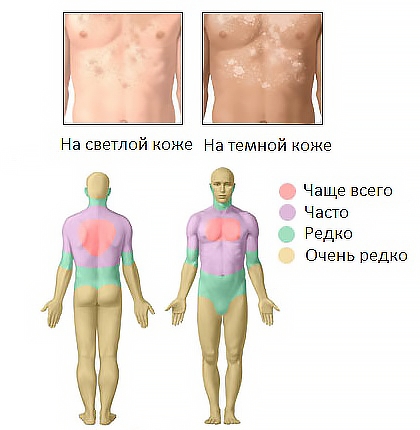Pityriasis versicolor or versicolor is a chronic dermatosis caused by the yeast Pityrosporum ovale.
The causative agent of lichen is an opportunistic microorganism that lives in the stratum corneum of the epidermis and hair follicles.
Pathology occurs with increased growth of pseudomycelium of the fungus. Pityriasis multicolor is not a highly contagious disease, but more often occurs with a certain state of the body.
Therefore, in order to treat the disease, it is necessary to find factors that provoke fungal manifestations.
Read on the estet-portal about the causes, symptoms, diagnosis and treatment of pityriasis multicolor.
Provocative factors: what causes increased reproduction of the fungus
Pityriasis versicolor occurs mainly in young people, with an exacerbation of the course in summer.
The causes of the disease include endogenous and exogenous factors.
Among the endogenous are:
• genetic predisposition;
• endocrine diseases;
• chronic foci of infection;
• hormonal imbalance in the body;
• immunodeficiency states;
• pregnancy and menopause.
Exogenous factors include:
• long-term treatment with corticosteroids;
• climatic conditions (hot and humid climate);
• intense ionizing and ultraviolet radiation;
• wearing tight synthetic clothing;
• chronic stress and bad habits.
Everything that leads to increased sweating and sebum secretion can be the cause of pityriasis versicolor.
But most often, the manifestation of the disease requires the action of several factors.
Follow us on Telegram
Clinical picture of versicolor: characteristic "leopard color"
Lichen versicolor occurs in two forms: localized and disseminated. Most often, the upper body, shoulders, neck, armpits, abdomen, groin, genitals are affected.
The rash elements are presented in the form of spots with clear edges: hypo- or hyperpigmentation.
Lesions also tend to enlarge and coalesce, forming patterns resembling a geographical map.
Characteristic for multi-colored lichen is the appearance of peeling on the spots, which disappears with the treatment of the disease.
Also, in some patients, fungal folliculitis or seborrheic dermatitis may occur against the background of lichen versicolor.
Forget about hyperpigmentation forever: the most effective methods of correction

Wood's lamp is also widely used in a darkened room. Under the Wood's lamp, the affected areas of the skin have a characteristic greenish-blue glow.
Differential diagnosis of pityriasis versicolor is carried out with lichen rosea, guttate psoriasis, vitiligo, syphilitic leucoderma, and post-inflammatory hyper- and hypopigmentation. : modern approaches and recommendations
Pityriasis versicolor: basic treatment and prevention of the disease
Treatment of a fungal disease depends on the location and form of the disease.
If the fungus affects the scalp, shampoos containing fungicidal agents are used for 7-10 days.
In case of widespread form of versicolor versicolor and frequent relapses of the disease, it is necessary to conduct a course of systemic treatment with ketoconazole or itraconazole at a dose of 200 mg per day for 7-14 days.
Prevention of the disease consists in good skin care, personal hygiene, strengthening the immune system, treating concomitant diseases, avoiding the aggressive effects of UV radiation and synthetic clothing.Thank you for staying with estet-portal.com . Read other interesting articles in the "Dermatology" section. You may also be interested in:
Pityriasis rosea of Gibert: etiology and prevalence of the disease







Add a comment